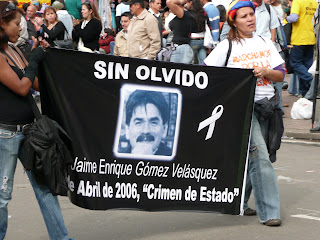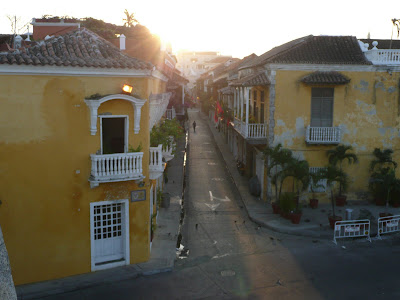Beasts of Burden
In the high sierra horses and mules are used by the campesinos to transport goods to markets, as this farmer coming into the village of El Cocuy.

Leaving Tunja, I couldn´t help but compare my sturdy stead to the beast tied up to the post. In Colombia they call the bicycle el caballito del acero or the little iron horse, reminiscent of the Tibetan jota.

It was a huge climb from the dry Chicamocha valley (900m) to the high paramo above Belen, reaching an altitude of 3420m. Then onto the hot springs of Paipa to soak tired limbs and bum. Back on a busy highway now after days in the sparsely populated sierra but arriving in Tunja was just rewards. It´s been my favourite town so far, a nice mix of colonial and modern. This is the main plaza with the ubiquitous statue of Simon Bolivar the Liberator. He fought his major battle against the Spanish just outside Tunja.

In Tunja I found a nice family-run hotel,the Hotel Saboy. This massive bedroom cost me 10,000 pesos or A$6 a night.

Compared to this litle box in Zipaquira which set me back 15,000 pesos!

From Tunja I rode down to Villa de Leiva, a oolonial town untouched by modernisation, but after Tunja it lacked vitality- all whitewashed facades. But there was a very interesting fossil museum in the hills- dinosaurs and amonites. Further down the road, Raquira with pastel-coloured shops and houses. Here is the small church in the plaza before an incredible thunderstorm.

The Return of the Chaser
A very strange day. Leaving Raquira on a rocky steep path I was followed by children on the way to school. Laughing and teasing me, they pursued el Australiano until they reached the school at the top of a hill. Then it was the pesky dogs turn. Passing by smoking kilns and stacked terracotta pots (Raquira is famous for pottery) every litle house owned a mutt or two. They would see the bike and chase me up the road (still climbing on the stony jeep track). Unlike the Tibetan mastiffs they either gave up the pursuit or I threw rocks at them, which sent them whimpering home.
Over the pass and into a wide valley of small dairy farms. Evocative smells of childhood on a farm in NW Tasmania - mud and diesel, mingled with warm cow shit and the fresh scent of wet eucalypts (common throughout Colombia). Enjoying a leisurely ride on a muddy gravel road when I was greeted by this over-friendly horse. It reared up and tried to knock me off the bike so off I scarpered down the road with this frisky horse in hot pursuit. He seemed to enjoy this game but he would catch up to me and try to nudge me off the bike. Did he want a ride? Was he sexually excited by el cabellito del acero? Or was it just another day at the races? It went on for 6kms until I arrived at a road junction. An old woman inquired "Is it your horse?". I convinced her it wasn´t so she sent her daughter to escort the wild beast back to the finca where he belonged. What´s up next? I guess I´ll be chased by pigs in Ecuador and llamas in Peru.
The fun hadn´t finished yet. Back on the autopista (highway) with the fumes and noise of trucks and buses. Climbed the pass leading to the plain of Bogota and just I reached 3000m, the heavens opened up with hail, thunder and sheet lightning. No escape so I hurtled down to Zipaquira 30 kms away, followed by this impatient and erratic storm. 2 hours later, a hot shower and some beers. What a day!
The Great Political Divide posters- anti-FARC demo Feb 4

Left wing anti-Uribe rally March 6

I cycled into the centre of Bogota and ran into the middle of this large rally. Many people holding photos of the disappearred and murdered by paramilitaries. Many different groups took part- trade unions, students, relatives of the victims, indigenous groups etc. It became violent at the Plaza de Bolivar when radicals clashed with the military.





Colombian beauty getting ready for a pageant

Bike path in Bogota. The city has built these shared paths everywhere. Every Sunday 100s of kms of roads are closed to traffic and the cyclists, joggers and walkers take over the streets. Imagine this happening in Australia.....a car-addicted society? Anyway, I`m joining the throngs today (Sunday March 9) as I cycle out of town, heading south.








































